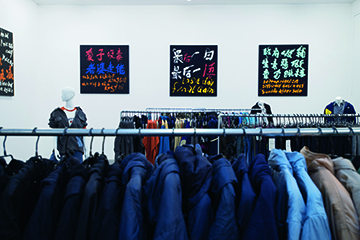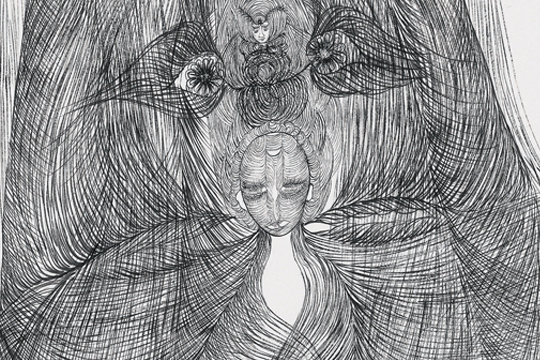Outside The Traditional, Within The Contemporary
| December 30, 2013 | Post In LEAP 24
In the last thirty-some years, most exhibitions of contemporary art in China have been spontaneous, community events, although such events have not yet been entirely accepted by society as part of mainstream culture. Of course, as contemporary art moves from the popular towards the elite, contemporary artists have also moved to adapt to the careers laid out for them by the system. Against this backdrop, many artists have returned to the old ways in both thought and practice, continuing the mutual displacement, misreading, and recombination of the dichotomies of folk and elite, and contemporary and traditional.
On the one hand, there have always been arguments suggesting that Chinese painting is a dead end and the lowest of traditions. On the other hand: the work of Qi Baishi was the first to represent New China at the Venice Biennale, the Handicraft Export and Exhibition Policy of 1984 defined paper-cutting as traditional art which could be sent overseas for exhibition (which it subsequently was), and unofficial art organizations sent qigong folk paintings to Venice in 2013, which fit the curatorial framework for “Il Palazzo Enciclopedico” “perfectly”, sparking intense debate in domestic art circles. Not only are contradictions between folk versus elite and traditional versus contemporary mutually interwoven, but the contradiction between the local and international exchange is also sporadically present.
People often return to the old ways because of their resentment for capitalism and globalization, just as people often turn to contemporary art because of their resentment for the hidebound reality of classical rules. In both cases, the suppressed role of “folk” emerges.
Qigong paintings were never at the cutting edge; their emergence and popularization have more to do with the ancients’ ideas of nature and the body. In essence, they are a visible vestige of the coordinated movement of body and spiritual consciousness, similar in origin to ancient Chinese painting and calligraphy, and with similar visual characteristics. However, successive generations either failed to conduct systematic research or to preserve such scholarship; when facing such visual patterns today we can do no more than gasp in shock and curiosity, incapable of penetrating the experience on a perceptive level, and even more incapable of transcending the conventional to interpret and judge what we have seen.
The village collective of Mazhuang Village in Hebei Province created this imitation antique Buddhist image using period techniques: a naked, sensual body, covered in characters denoting meridians and acupuncture points, a cultural symbol and physical imagination reflecting a secular visual appeal. The villagers’ creation is just one example of how the modern Chinese market economy has influenced cultural production.
In both China and the West, a lack of prominence and unqualified neglect of the individual in the dominant discourse leads to the obscuring of folk collective or anonymous creative work, both from antiquity and the present day. Such artworks are deemed to lack a sense of the sublime, and are not seen as pure art. In ancient times, two cultural systems existed side by side in China: that of the common people and that of the scholars. To a large extent, this was simply putting a name to the social elite’s custom of Otherizing the common people, even though a profound connection existed between the two in a society dominated by agrarian culture. The diametrical opposition of the refined and the vulgar in traditional Chinese society means the traditional folk culture resources of both groups are far more likely to receive approbation in contemporary artistic and cultural treatises, which oppose the idea of alienation and advocates dispensing with the old in favor of the new.
Many contemporary artists today express their search for the ideas of nature and harmony seen in traditional images through both their thinking and their practice, sometimes so much so that their artworks feature similar aesthetic characteristics. However, even though the people of ancient China “sometimes expressed a yearning for nature, such yearnings were merely a refuge; given the opportunity, the Chinese people could return immediately to the realities of society.” The so-called “nature” of traditional Chinese culture never transcended imperial control, and instead became regulated as a means of escape, a way to maintain good health, or to alleviate social conflict. Exceeding these boundaries was strictly forbidden.
As a result, the pursuit of expressions of hidden potential, physical strength, and the power of natural mystery in historical artworks is in truth a search for equality. It is not merely the expression of physical experience or ideas of nature: it is also the desire to struggle against authority.

The nostalgic faction and the conservative faction are diametrically opposed, as those who are nostalgic believe the current situation cannot change and look instead to ancient times, while those who are conservative are resolute in their view of the ancient as a weapon to fight the dilemmas of the present.
To take the calligraphy of the small contemporary art collective Yangjiang Group as an example: while this quintessence of Chinese culture has on the one hand been sorely marginalized by the realities of contemporary life, it has on the other hand increasingly become a symbol of the expression of national culture. In popular imaginations of calligraphy, the calligraphy of Yangjiang Group and street life are intimately related. For example, bankrupt hawkers selling clothes use calligraphy brushes to write “Lost Everything I Owned”; anyone who wants to play the lottery game Mark Six must be able to write characters; and illiterate people sell New Year scrolls they have copied out themselves. Over the past ten years of writing and exhibiting their work, Yangjiang Group has adopted the writing methods common among the dregs of society. This aesthetic cognition, born entirely out the experience of local life, is not only a departure from the defined aesthetics of traditional calligraphy; it is also to a great extent distancing itself from what is gradually becoming the mainstream representation of ink painting. It emphasizes the confrontation between elite consciousness and the right of the commoner to write. It offers form to this situation, its contemporary significance far removed and far more important than the ancient tenets of a calligraphy are that require decades upon decades of practice.
At the same time, it is evident that Yangjiang Group’s skillful use of installation, site construction, and performance are all in accordance with contemporary art’s rules of the game. As Yangjiang Group themselves are long since active participants in the art system, the changes, adjustments, and thinking behind their work is tangible, visible, and traceable. But ultimately, the charm behind their creativity comes from a passion for life shared by those on the lowest rung of society. The powerful pulse of this passion continues to throb not only in the current gradual demise of the foundations of agricultural civilization, but also in the logic of exhibition and dissemination driving contemporary art.



